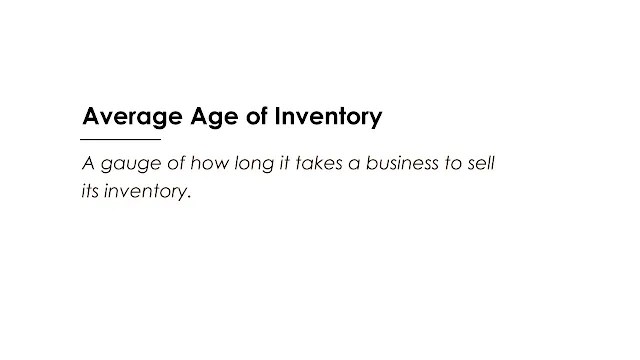 |
| Image: Moneybestpal.com |
The average age of inventory, commonly referred to as days' sales in inventory (DSI), is a gauge of how long it takes a business to sell its inventory. It reveals the effectiveness and profitability of a business's sales and inventory management.
A business may turn its inventory into cash more quickly the younger the inventory is on average. A corporation maintains its inventory for longer when the average age of its inventory is higher, which may indicate lower demand, higher storage costs, or a larger risk of obsolescence.
How to Calculate the Average Age of Inventory?
The formula to calculate the average age of inventory is:Average Age of Inventory = (Average Inventory Cost / Cost of Goods Sold) x 365
Where:
- Average Inventory Cost is the sum of the inventory's average values over a period of time, often one year, at its current level. You may figure it out by summing up the beginning and ending inventory balances and dividing the result by two.
- The cost of goods sold (COGS) is the sum of the costs incurred over the same time period for both production and sale of the commodities. It can be determined by adding the beginning inventory and purchases together and then subtracting the ending inventory from the total.
- The number of days in a year is 365.
The number of days before a corporation sells its inventory balance is represented as the average age of inventory and is expressed in days.
Example of How to Calculate the Average Age of Inventory
Let's say Company A has an average inventory cost of $100,000 and a COGS of $600,000 for the year 2023. Using the formula above, we can calculate the average age of inventory as follows:Average Age of Inventory = ($100,000 / $600,000) x 365
Average Age of Inventory = 0.167 x 365
Average Age of Inventory = 60.83 days
This means that Company A takes about 61 days on average to sell its inventory.
Why Is the Average Age of Inventory Important?
The average age of inventory is an important metric for several reasons:- It aids in determining a company's liquidity and cash flow. Inventory with a lower average age can be sold more rapidly, generating cash that can be used to settle debts, fund new initiatives, or pay dividends. A company's financial flexibility and growth potential may be hampered by a higher average age of inventory since it has more capital invested in it.
- It aids in assessing the effectiveness and profitability of a business's inventory and sales management. A company with a lower average age of inventory has a higher turnover rate and greater demand for its goods, which could be a sign of a competitive advantage or a strong market position. A lower turnover rate and low demand for a company's products are indicated by a higher average age of inventory. This could be a sign of poor sales performance, excess or obsolete inventory, or ineffective inventory management.
- It aids in comparing various businesses or sectors. Depending on the type and attributes of the products, such as their shelf life, seasonality, or fashionability, the average age of inventory might vary significantly. For instance, the average age of inventory is very low for perishable commodities like food or flowers but quite high for durable goods like furniture or machinery. Consequently, it is helpful to compare the average age of inventory among businesses or industries that produce comparable goods or serve comparable markets.
How to Use the Average Age of Inventory Effectively?
The average age of inventory is a useful metric for MBA students who want to analyze and improve the performance and profitability of a company's sales and inventory management. Here are some tips on how to use it effectively:- Utilize it in addition to other measures. An incomplete picture of a company's financial health or operational effectiveness cannot be obtained from examining the average age of its inventory alone. It should be used in conjunction with other measures, such as the inventory turnover ratio, return on assets, and gross profit margin, to obtain a more thorough and accurate picture.
- Use it sensibly and in the right context. The assumptions and historical data used to calculate the average age of inventory may not accurately reflect the present or future state of a company or its market. It may also be impacted by other factors that are beyond a company's control, such as prevailing economic conditions, consumer preferences, or technology advancements. Therefore, it is crucial to utilize information in context, with caution, and to make adjustments for any substantial alterations or abnormalities that can skew its relevance or meaning.
- Use it to spot issues and chances. For a business's sales and inventory management, the average age of inventory can assist in detecting potential issues or possibilities. For instance, a corporation may need to address inventory concerns like overstocking, underpricing, or poor quality if its average age of inventory is increasing. A corporation may have sales possibilities that can be taken advantage of, such as rising demand, strong pricing, or product differentiation if its average age of inventory is decreasing.
